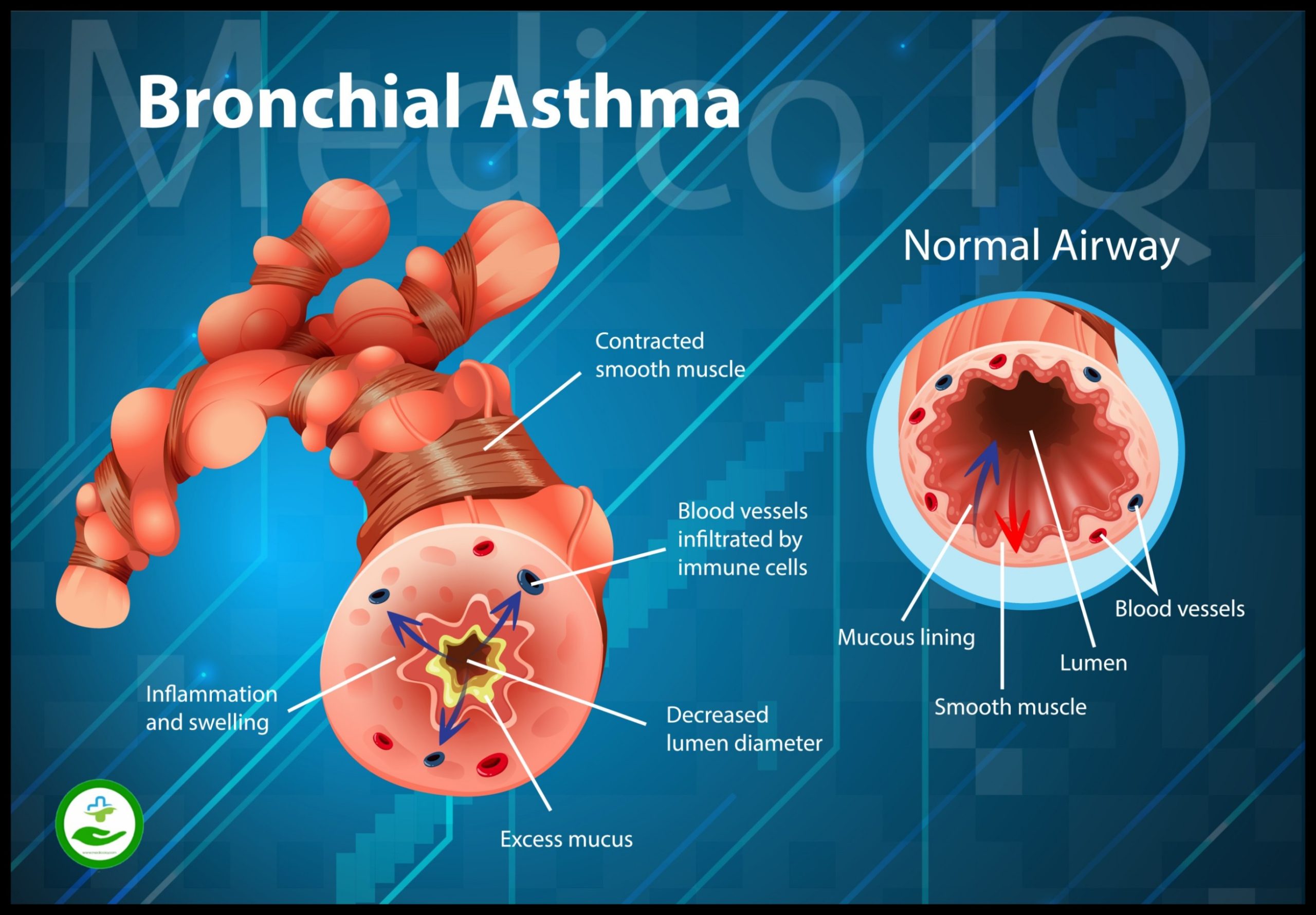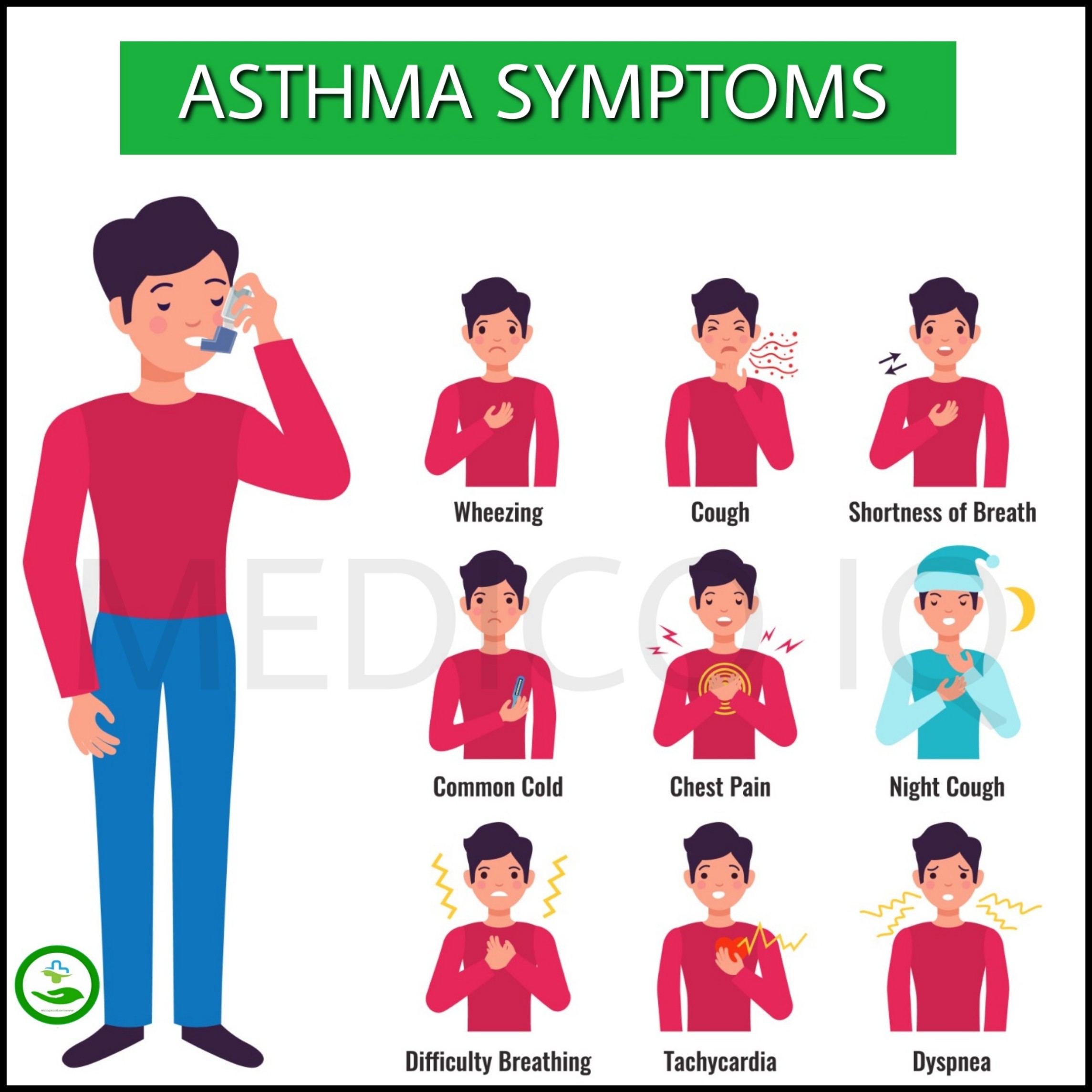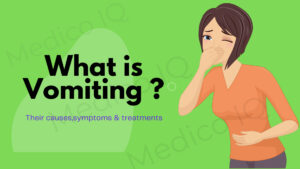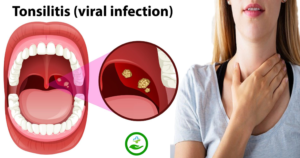Table of Contents
Asthma Pathophysiology
Hello guys welcome to medico IQ in this article we cover Asthma Pathophysiology, Symptoms, Causes & Treatment
Introduction : Approaching Airway Inflammation
Asthma is a chronic lung disease that inflames and narrows the airways which produce extra mucous. This means they swell and produce thick mucus and it is the condition of the long term.
For knowing asthma pathophysiology fist you need to understand the asthma and its is a condition the airway thin and swelled and produces more extra mucous and this condition can difficulty breathing, trigger coughing, and wheezing (sound during inspiration).
The airway lumen is a tube that carries air in and out of the lungs if any patient has severe asthma so their wall of the airway smooth muscle is swollen & Painful. Asthma is a condition that affects the air passes of the lungs. It is a three-step problem.

Asthma Pathophysiology
Asthma pathophysiology is characterized by inflammation of the mucosal lining of the bronchial tree and spasm of the bronchial smooth muscle .This cause narrowed airway and air trapping. The asthma pathogenesis of severe asthma is complex & not fully understood. Its also know us airway diseases
It involves a number of inflammatory cells, inflammatory mediators, nerves, and vascular leakage that can be activated by several different mechanisms, of which exposure to allergens is the most important. Three factors contribute to the finding of obstruction
Process Pathophysiology Of Asthma
- Inflammation of airway
- Bronchial smooth muscle and mucous gland enlarged
- Sputum produced and alveoli hyperinflated
- The person who is suffering from asthma develop an immune response to their alveoli fibrotic changes in the airway lead to narrowing and potentially irreversible airflow limitation.
- The mast cells is activated (Which is play key role for inflammatory)
- Release mast cells production (Histamine Prostaglandin bradykinin)
- Allergy inflammatory reaction
- The release of that mediator in lungs tissue affect the smooth and gland of the airway
- It causes bronchospasm mucus membrane swelling and excessive mucus production
View video of Asthma Pathophysiology
Types Of Asthma
- Allergic asthma (Extrinsic Asthma) – The term allergic or extrinsic asthma used when the symptoms are induced by the hyperimmune response to the inhalation of specific allergens, such as
Allergic asthma is more likely to be seasonal because if often goes hand-in-hand with allergic that is also seasonal”
- Non-Allergic Asthma (Intrinsic Asthma) – This type of asthma is triggered by an irritant in the air that is not related to allergic Including
- Mixed Asthma- Mixed asthma has included of both allergic and nonallergic. It’s the most common form of asthma.
- Cough Variant asthma- It is characterized by one symptom, a persistent dry cough. Cough variant asthma leads to full-blown asthma that shows other asthma symptoms.
- Exercise Included – This Asthma affects people after physical activity. EIA asthma occurs in people who are not sensitive to classic asthma triggers like pollen, dust dander, etc.
- Nocturnal asthma- This type of asthma is characterized by asthma symptoms that worsen at night .Who suffer nocturnal asthma can also experience a symptoms any time of the day. However certain triggers such as heartburn, pet dander, and dust mites.
Causes of Asthma Pathophysiology
Generally, the cause of asthma is clearly not understood but some combination factor like the environment and the energetic factor is show and confirm their causes.

Some point is given in below…
Asthma Symptoms and Signs
Asthma signs and symptoms are similar to other diseases with airflow limitations like chronic bronchitis.
- Wheezing – Wheezing is a whistling noise heard during breathing. It is the result of air being forced through the narrower constricted air passage.
- Coughing – Cough is one of the most common asthma problem . The cough may be dry and wet and might worsen at night, early in the morning, or after exercise.
- Shortness of breath – Shortness of breath is the feeling that breath is barely finished before another is needed. It has been described as air hunger by some people.
- Mucus Production – Many People with asthma produce excessive, thick mucus that obstructs the airway, which can lead to coughing.
- Chest Tightness -This may feel like something is squeezing or sitting on the chest. As muscles surrounding the airway constrict, the patient may experience a feeling of tightness in the chest.

Diagnosis
Spirometer– This Device Measures how much air you can exhale and how forcefully you can breathe out. The test may be done before and after you take inhaled medication. The spirometer is a good way to see how much breathing is impaired during an attack.
Peak Expiratory Flow Determination -: Measure the ability to push air out of the lungs or how fast air can be exhaled. This test uses a small device called a peak flow meter and can be performed by the patient at home to monitor lung function.
Chest X-Ray – These tests will help find out whether a foreign object or another disease may be causing symptoms. A chest x-ray may be necessary to indicate hyperventilation.
Allergy Blood testing-: Blood tests that are specific for the allergen suspected to be causing symptoms such as a dust mite, mold, pet, dander, and pollens. allergy blood testing may be ordered to help determine asthma triggers.
Are you irritate with Sinusitis? Don’t Worry treat your sinusit like that!
Treatment
Asthma has 2 types of treatment medicine 1st is “long term control” and the second one is “quick-relief medicines”. Basically, Long term control medicines help to reduce airway inflammation of the lungs and prevent asthma. And quick-relief medicines relieve asthma complaint.
A. Long-term Control
This treatment is to help that person who has needed to take daily medicines to prevent asthma symptoms.They do not give quick relief from their symptoms. Long term control medicines reduce airway inflammation.
Types of long term control medications-:
Inhaled Corticosteroids:
Inhaled corticosteroid is the preferred medicines for long term medicines control of asthma.
- These medicines are the most effective long term control medicines to relieve airway inflammation and swelling that make the airway sensitive to a certain substance that is breathed in.
- These medications included budesonide, fluticasone, flunisolide, mometasone, beclomethasone, and triamcinolone.
- The patients with asthma may need to use these medicines for several days to weeks before they reach their maximum benefits.
Leukotriene Inhibitor:
- The name of Leukotriene inhibitor medication is Zileuton(Zyflo), Zafirlukast (Accolate) and Montelukast (Singulair).
- They are another group of medication which control the asthma.
- Leukotriene is a potential chemical substance that helps to create inflammation during an acute asthma attacks.
- The leukotriene inhibitor medicine blocks this chemical and reduces the inflammation of tubes.
Long-acting beta-agonist:
- Salmeterol, formoterol, bambuterol, salbutamol, terbutaline are the medicine of long-acting beta-agonist.
- This drug is chemically related to adrenaline this hormone is produced by the adrenal glands.
- inhaled long-acting beta-agonist works to keep breathing passage open for 12 hours.
- They relax the muscle, the breathing passage, and decreasing the resistance to exhaled airflow, making it easier to breathe.
- And they also help to reduce inflammation.
Combination Inhalers:
- Fluticasone and salmeterol, budesonide, and formoterol are examples of combination inhalers.
- These medications contain Long-acting beta-agonist along with corticosteroids.
Methylxynthine:
- Theophylline and aminophylline are examples of methylxanthine drugs.
- This Medication is chemically related to caffeine and methylxanthine is works as long-acting bronchodilators.
- At one time methylxanthines were commonly used to treat asthma.
- Generally, this medicine uses less in the treatment routing of asthma because caffeine gives a side effect.
- Generally, this medicine using less in the treatment of asthma because caffeine gives a side effect.
Cromolyn sodium: This drug is especially useful for people who have to develop asthma attacks in response to certain types of allergic exposure when taking regularly prior to exposure, cromolyn sodium can prevent the development attack of asthma.
Omalizumab:
- It is a humanized monoclonal antibody.
- Omalizumab belongs to a newer class of agent that works with the body’s immune system.
- In people who have a high level of immunoglobulin, E(IgE), an allergy antibody, this drug is given by injection may be helpful with symptoms that more difficult to control.
- This agent inhibits IgE binding to cells that release chemicals that worsen asthma problem.
- This binding prevents the release of these mediators thereby helping in controlling the disease.
B. Quick Relief Medication
Quick-relief medication is used as needed for rapid for asthma management, short term symptoms relief during an asthma attack. Or before exercise, if the doctor recommends it. Types of quick-relief medication include
- Short-acting beta-agonist
- Anticholinergics
1.Short Acting Agonist –
- Albuterol, Levalbuterol, and pirbuterol are the example of short-acting agonist.
- They work rapidly, within minutes to open the breathing passages, and the effects usually last four hours. short-acting agonist most commonly used medication.
2.Anticholinergic –
- Anticholinergic are another class of drugs useful are rescue medication during asthma attacks .
- Inhaled anticholinergic drugs open the breathing passes similar to the action pf beta-agonist.
- Inhaled anticholinergic take slightly longer than agonists to achieve their effect, but they last longer than an Alpha agonist .
- An anticholinergic drug is often used together with beta-agonist drugs to produce a greater effect than either drug can achieve by itself .
- Ipratropium bromide is inhaled anticholinergic drugs currently used as rescue asthma medication.
3.Oral & Intravenous Corticosteroids:
- Prednisone and methylprednisolone is an example of intravenous corticosteroids.
- This drug use only on a short-term basis for severe asthma because it can cause serious side effects when using long term.
Home Care Of Asthma
Avoid Trigger – Keep away from exposure to an allergen, that trigger asthma symptom is a key part of asthma control.
Drinking Enough water- Water is being well hydrated keep your mucus thinner aiding breathing as well as digestion. Drinking water is good for the asthma management of asthma and so many ways.
Use Air Conditioner- Air conditioner reduce the amount of airborne pollen from trees, grasses, and weeds that find their way indoors. Air conditioning also lowers indoor humidity and can reduce exposure to dust mites.
Clean Home Regularly- Keep clean your home. We suggest you deep clean your home once a week, from having too much dust, with wear a face mask because dust is a trigger point of activating asthma disorder.
Get Regular Exercise– Do exercise regularly because regular exercise can gain strength in your heart, lungs, brain which helps to relieve severe asthma symptoms. Generally, treatment can prevent asthma attacks and control symptoms of asthma but exercise gives you long-term relief.
Maintain a Healthy Weight- Being overweight can worsen asthma symptoms, and it put you at higher risk factors of other health problems.
Eat healthy foods, fruits, and vegetables- Avoid food that is higher in sugar and fried foods. Eating fresh fruits and vegetables may increase lung function and reduce asthma symptoms. These foods are rich in protective nutrients that increase your immune systems.
Minimize Pet Dander- If you are allergic to dander, avoid pets with fur or feather . Having pet regularly bathed or groomed also may reduce the amount of dander in your surrounding.
Avoid Fragrance spray- Perfume, room freshener, cleaning spray, and mosquito-killing spray is very dangerous for asthma patients, it can cause so many problems on lungs and respiratory system and also provoke asthma attacks , so that’s why always avoid this type of harmful product from an asthma patients.
Do not take cough medicines- This type of medicine does not help asthma and may cause unwanted side effects.
Do Not take anti-inflammatory and nonsteroidal drugs – For example, Aspirin ibuprofen can cause severe asthma to worsen in certain individuals.
Prevention Program
A doctor understand the asthma pathophysiology then doctors can develop a step-by-step plan of action even though asthma can be prevented by taking drugs. Take action against asthma. Make a thorough plan that outlines the administration of medication and how to handle an severe asthma attacks.
Keep an eye on your plan. Asthma is a chronic condition that necessitates ongoing observation. Controlling your medical care will assist in controlling your life.
Examine the breath. You may start to notice asthma signs like a little cough and shortness of breath if a patient’s breathing is being compromised.
Understanding Asthma Pathophysiology Diagnosis & Asthma Management
Asthma is characterized by hyperresponsive airways that induce wheezing, coughing, a tight chest, and shortness of breath. Asthma is a chronic respiratory inflammatory illness.
Usually, there is an airflow restriction during this phase, which can be corrected or reversed spontaneously. 400 million people throughout the world suffer from asthma.
Asthmatic Children are more likely to be male and more likely to be female. Asthma can be brought on by a variety of hosts, environmental factors, and interaction of factors, according to experts. Genetic factors and gender-specific obesity are hosts. Atopy’s existence is also influenced by genetics.
Asthma Management
- Acute and prolonged therapy is used to treat and prevent asthma.
- The age, illness severity, and complications all play a role in the medication decision.
- Before beginning the therapy, be sure your history of severe asthma treatment is accurate.
- Patients who take asthma drugs may not be able to take other medications.
FAQs
What is the basic pathophysiology of asthma?
Acute respiratory asthma causes airway inflammation and intermittent bronchial obstruction.
What happens during an asthma attack pathophysiology?
In asthma a swollen airway is enlarged and inflammation can occur.
The muscles around your airway contract and your airway creates excess mucus which reduces breathing tube diameters.
When the attack occurs, the coughing can become very painful. 1st Oct. 2122.







